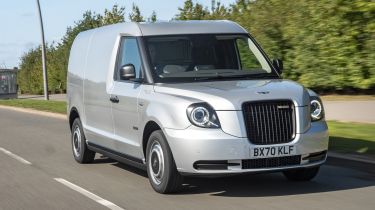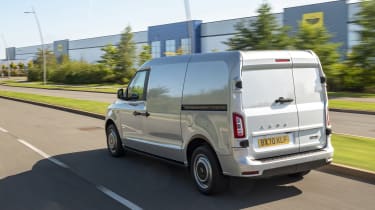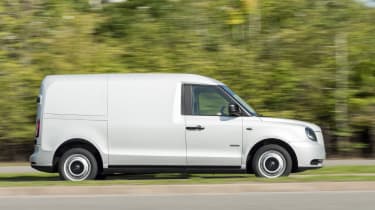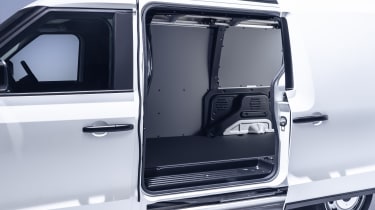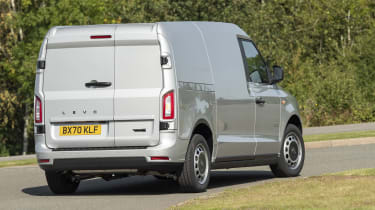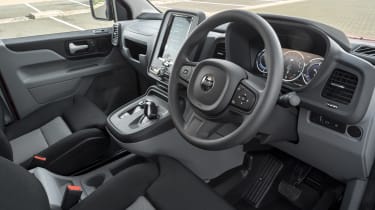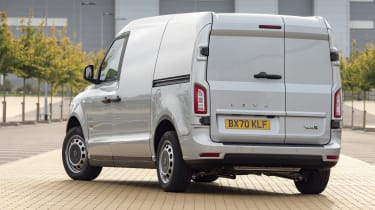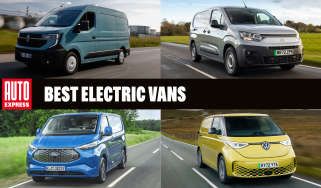LEVC VN5 van review
British firm LEVC breaks out of the taxi ranks with its new VN5 range-extending van
This is the LEVC VN5, a one-tonne van from the Coventry-based company that's most famous for building the TX taxi. In a nod to the taxi, the VN5 features the same front end design, and it's largely identical under the skin, too. That means this van features a range-extender (REx) drivetrain, with an electric motor driving the wheels and a petrol engine on board that cuts in when the battery is flat.
In many ways it's a pioneering van concept. Only the Ford Transit Custom offers a similar plug-in hybrid (PHEV) drivetrain, but the VN5 has been engineered as a PHEV from the outset, rather than being a diesel van that's had its drivetrain swapped out. As a result, the VN5 has a larger battery than the Ford (31kWh compared to 13.6kWh), and therefore it can drive further on electric power alone. LEVC's aim is to offer a van that can be used in a zero-emissions zone for a days work, but then have enough energy in reserve so it doesn't need recharging. The LEVC VN5 has a pure electric range of 61 miles, and an overall range of around 300 miles with a full tank of petrol as well.
Used - available now

2022 Fiat
500
22,532 milesManualPetrol1.0L
Cash £9,549
2023 Honda
Jazz
24,192 milesAutomaticPetrol1.5L
Cash £14,999
2022 Vauxhall
Corsa
30,379 milesManualPetrol1.2L
Cash £11,549
2022 MINI
5-Door Hatch
32,498 milesAutomaticPetrol1.5L
Cash £15,049The van itself has a two-box shape that's familiar from the small van sector, but it's actually at the larger end of the medium-sized van class. At the moment it comes in just one body style, a panel van with a sliding side door and offset barn doors at the rear. They open to reveal a load area that has a capacity of 5.5 cubic metres, while there's a payload of 830kg. These aren't outstanding figures, but it's enough for the kind of urban deliveries and journeys that the VN5 is expected to undertake.
Like the TX taxi, the VN5 features aluminium construction under its plastic body panels. The van has a 400mm longer wheelbase than the taxi to create a larger load area, but the rear-wheel-drive layout means LEVC has retained the taxi's steering rack to create a tight 10.1-metre turning circle. There's a steel bulkhead between the load area and passenger compartment and a two-seat layout, but the cabin design precludes the option of fitting a third seat between the driver and passenger.
The VN5 is offered in three trim levels – Business, City and Ultima – and even the entry-level van is well equipped. LEVC is owned by Chinese firm Geely, which also owns Volvo, and some of the Swedish company's tech has found its way into the VN5. The nine-inch portrait screen is the same one that you'll find in a current Volvo, while standard kit on all vans includes automatic LED lights, auto wipers, Bluetooth, twin USB ports, dual-zone climate control, keyless starting and a digital dashboard. There's also lots of Volvo-sourced safety kit, including autonomous emergency braking, adaptive cruise control and plenty of airbags, while kit such as lane departure warning, road sign recognition, front and rear parking sensors and a rear camera all available.
The raft of kit goes some way to justifying the price of the VN5. It's for sale from around £47,000, and it also qualifies for the Government's £8,000 Plug-in Van Grant. As for rivals, there aren't any direct competitors to the VN5, but there are eco alternatives. The Ford Transit Custom PHEV has a similar overall driving range and has a larger payload and cargo capacity, but it can't match it for EV-only driving. All-electric vans such as the Mercedes eVito and VW e-Transporter can carry more, but with an overall range of around 90 miles and no range-extending back-up, you'll be charging them up while the VN5 keeps going. The new Vauxhall Vivaro-e (as well as the Peugeot e-Expert and Citroen e-Dispatch) can travel further between charges, but still have an overall range which is half that of the VN5.
MPG, CO2 and running costs
As with many other plug-in hybrid vehicles, the LEVC VN5 has a relatively high list price, but owners will reap the benefits in terms of running costs - as long as the battery is kept at a full charge. The range starts at around £47,000 for the Business version, with the City and Ultima versions around £1,000 and £5,000 extra. Go for the top-spec Ultima model, and you're getting one of the best-equipped vans on the market. There's a heated windscreen, heated seats with electric adjustment, sat-nav, side curtain airbags, lane departure warning and road sign recognition, front and rear parking sensors and a rear camera.
The VN5's plug-in hybrid drivetrain comprises a 148bhp electric motor combined with a 31kWh battery and a Volvo-sourced 1.5-litre turbocharged three-cylinder petrol engine that acts as a generator. With a full charge and tank of fuel, you can expect a range of around 300 miles, with the van able to drive on battery power alone for 61 miles. LEVC also quotes a CO2 figure of 21g/km, significantly lower than the 81g/km for the Transit Custom PHEV.
Charging the 31kWh battery is done via one of two charging ports in the nose of the VN5, either side of the upright grille. One is a Type 2 socket for standard charging, while on the other side is a high-voltage Chademo socket. This means charging from a mains plug, purpose-built wallbox or public fast charger are all possible, with charging taking as little as half an hour via a DC charging source.
The thinking behind the LEVC VN5 is that it's ready to do a day's work on a full charge and tank of fuel. That battery range of 61 miles is ideal around town, but a user can save this while travelling at higher speeds – from a depot to a city, for example - and they will be unlikely to need to stop to recharge the van during the day, so there's more time dedicated to work.
We haven't driven a VN5 for a prolonged period to see how all of this theory translates into real-world use, but the standard PHEV mantra holds true for the VN5: plug it in as often as possible to reap the benefits. Run on electricity as much as you can, and you'll soon recoup the van's initial purchase price. With that decent 61-mile range available to you, it's also possible to avoid visiting petrol stations for weeks on end.
Load space and practicality
While the LEVC VN5 is a pioneer in terms of plug-in tech, it's a bit of a compromise for practicality. It's the first vehicle that LEVC has built that isn't a taxi, so there isn't the broad range of choice you'd get from a traditional high-volume van manufacturer. There's just the single panel van body style on offer which comes with a single sliding side door and offset barn doors at the back.
The LEVC VN5 has a cargo capacity of 5.5 cubic metres and a maximum payload of up to 830kg. This is less than most medium-sized panel vans (the Ford Transit Custom has 6.0 cubic metres of space while the PHEV is able to carry well over a tonne), which is a surprise considering the VN5 is actually larger than most vans in this class. The blame for this can be placed on the REx drive system. Because of its position between the axles and under the floor, it leaves the VN5 with a relatively high cargo floor. At least the floor area itself is large, with enough room for two europallets inside.
The side door slides to reveal an opening of 1,128mm, while the back doors lock open at 90 or 180 degrees. One trade-off of the high load floor is that the rear wheelarches don't intrude into the load area very much, while there are four lashing eyes in the cargo floor (eight in the Ultima) and six roof mounting points. That floor and the internal walls are lined for protection, while LEVC claims that the VN5 is ready to be converted with the minimum of fuss. There's a steel bulkhead dividing the cargo area from the cabin, which is slightly angled so there's a bit of extra floor space, but LEVC doesn't currently offer through-loading into the cabin.
Reliability and safety
One area where LEVC could be an unknown quantity is in terms of reliability. However, the TX taxi is designed to meet the tough requirements of London's Hackney Cab legislation, and since the VN5 is based on the same running gear, that should give some peace of mind. On top of that, LEVC did endurance testing of the VN5 before it went on sale, including subjecting the aluminium chassis to corrosion endurance tests, and putting all the doors through extensive opening and closing tests.
LEVC's standard warranty is five years/150,000 miles for the van and plug-in drivetrain, while the 31kWh battery has an eight-year/150,000-mile warranty. There is an option to extend this further, to six years/200,000 miles for the van and eight years/200,000-miles for the battery.
It's worth highlighting that because LEVC is part of the Geely group, it has access to plenty of technology from other brands within the Chinese conglomerate. Chief among these is Volvo, and there is plenty of switchgear and technology from the Swedish firm to be found in the cabin and under the skin. While it does give the VN5 a bit of a parts-bin feel (especially if you've driven a modern Volvo in the past few years), it also means there are plenty of tried-and-tested components on board.
Driving and performance
The real test of any new drivetrain technology - especially in a van - is how easy it is to get along with. Thankfully, the LEVC VN5 is just as easy to drive as any diesel auto van, but with far better refinement. For starters, all vans feature keyless starting - simply keep the key in your pocket, press the brake pedal click the rocker switch clockwise to turn the van on, and you're ready to go. Like other plug-in and electric vehicles, you're greeted by silence when the VN5 starts, and the only clue to the fact it's running is the dashboard lights switching off and the van's ancillaries start to run.
Move the stubby gear selector into drive, press the accelerator, and the standard-fit electric parking brake releases and you're away. The VN5 remains quiet on the move, with only a faint whirr from the on-board sound generator, which is designed to warn other road users of your presence. Tyre noise builds as you go faster, but the VN5 is still far quieter than any diesel van.
Van drivers are accustomed to torquey diesel engines that can handle a wide variety of weights and conditions, and thankfully the plug-in range-extending hybrid LEVC VN5 proves just as capable. There's 148bhp on offer, which is a medium to high output for a mid-sized panel van, but of more importance is the fact that this power - as well as the van's torque - is available as soon as you accelerate.
That means the VN5 is sprightly off the line, with the kind of instant acceleration that's familiar from most other electric vehicles. However, thanks to the van's rear-wheel-drive layout, there's no wheel-spinning drama as you pull away, the van's weight simply shifts over the rear axle, helping the tyres grip and getting you moving.
The VN5 does feel a little heavy for its size, but that's no different to a similar van carrying a payload, and the weight does help it to ride pretty comfortably. LEVC has recalibrated the steering over the taxi, but the wheel is still light, and the steering lock is tight enough that the VN5 can execute kerb-to-kerb U-turns pretty easily - it's certainly a far tighter turning circle than any other van on sale. One downside of the steering is that the wheel does tend to need constant correction when you're travelling at higher speeds on the motorway - the van does feel like it will wander a little if you're not giving your full attention.
One niggle that we found is that the wing mirrors are on the small side. Plenty of vans of this size feature twin wing mirrors with wide-angle glass in the lower section, but the VN5 can't even match those vans with single glass mirrors, so there are significant blind spots that you need to be aware of while driving.
With automatic drive, the VN5 is very easy to get along with. However, LEVC has borrowed its gear selector tech from Volvo, so rather than moving the shifter into your desired gear (Park/Reverse/Neutral/Drive) and leaving it there, you use the stick to click through to the gear you want. If you're not in tune with the system, you can easily shift from Drive into Neutral when what you need to do is move the selector once more to select Reverse. As we say, it's a little frustrating, but is sure to be something you get used to the longer you spend at the wheel.
The VN5 has a couple of features that help you to manage energy use when you're on the road. The first is available via the touchscreen, and allows you to pick a driving mode. Select Smart, and the van manages energy use automatically, and if you have a fully charged battery, you'll hardly ever resort to using the engine. When the engine does fire up, you can barely hear it, although there is a display showing real-ttime energy use.
A Save function allows you to keep the battery energy stored until you need it, which is the recommended setting for use on the motorway, and again, the engine is quiet enough to not be heard when on the move. The final setting is Pure EV, which leaves the engine off as long as there's enough charge left in the battery. Unlike some PHEVs, the VN5 isn't able to recharge the battery using the engine while driving. That's fine with us, because this sort of mode has a big impact on fuel economy that defeats the object of running a PHEV.
The other feature is braking resistance, and there are three settings on offer - a coasting function and two levels of resistance which are selected by moving the gear selector left or right. We found the highest setting the best to use, because it wasn't too harsh, although it's not strong enough to indulge in one-pedal driving around town. Some EVs and hybrids suffer from jerky braking as they switch between the electric motor slowing the vehicle to the physical brakes at the wheels, but the VN5 is actually very smooth when coming to a halt.
Cab and interior
Climb aboard, and the LEVC VN5 offers seating for two, while the dashboard layout means there's no scope for adding a third seat between them. The driving position is on the high side, and it feels like the bonnet is positioned low ahead of you, although this does give you a clear view of the road ahead. Build quality feels good inside, with plenty of plastic trim covering the whole interior. There's hard-wearing fabric upholstery, while the seats themselves are reasonably comfortable, although taller drivers might find the seat butting up against the bulkhead to get enough legroom.
The steering wheel is clearly taken from Volvo and is a multifunction item that controls the digital dials, also a Volvo-sourced item. The nine-inch portrait touchscreen is also from Volvo, and like that company's cars, the system isn't the most user-friendly to use when on the move. It uses swipe and pinch commands to select different menus, and when you're driving on a bumpy UK road it can be tricky to operate.
There are no armrests with the seats, while the position of the driver's seat relative to the door means there's no natural position to place your elbow on the door card. LEVC makes great claims about cabin comfort, but this is something that could do with addressing to make the VN5 even more comfortable to drive.
Cabin storage is so-so, rather than outstanding. There's enough room between the front seats to add a lidded cubby, but the VN5 only has a tray with a pair of cup holders included. There's a glovebox, average door bins and storage under the seats, while there's a modest amount of overhead storage and a couple of USB ports for charging devices.
Where the VN5 really impresses is with its driving assistance features. It's packed with safety kit, with twin airbags as standard, auto lights and wipers, automatic emergency braking and adaptive cruise control, hill start assist and tyre pressure monitors all fitted, too. Go for City or Ultima spec, and you get front and rear parking sensors, road sign detection, lane departure warning and side curtain airbags, too.
Van dimensions
| Height | 1,990mm |
| Width | 1,945mm |
| Length | 5,233mm |
Load area dimensions
| Height | 1,373mm |
| Width | 1,574mm |
| Length | 2,447mm |
| Volume | 5.5 cubic metres |
Now read about the Best small vans to buy...

